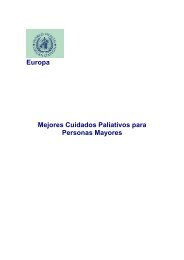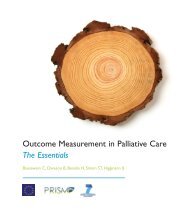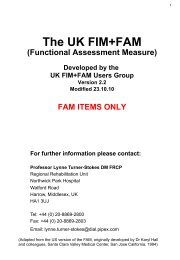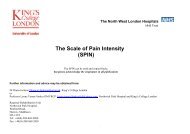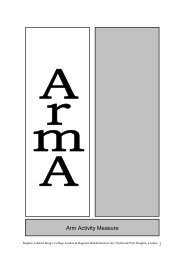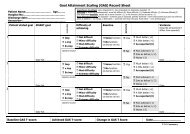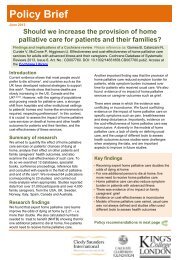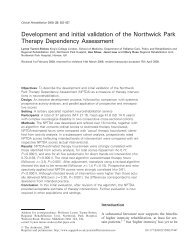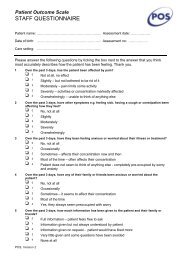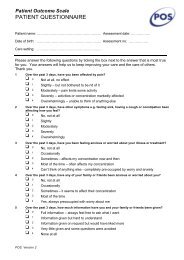The Rehabilitation Complexity Scale - King's College London
The Rehabilitation Complexity Scale - King's College London
The Rehabilitation Complexity Scale - King's College London
- No tags were found...
You also want an ePaper? Increase the reach of your titles
YUMPU automatically turns print PDFs into web optimized ePapers that Google loves.
Lynne Turner-Stokes, Rebecca Disler and Heather WilliamsFeedback regarding utility of the RCSFeedback about the RCS from the 49 centres was generally positive.In all, 76% reported that it was very easy or fairly easy tocomplete, and only one said it was ‘fairly hard’; 55% thought itdistinguished complex cases and 81% said that they would bewilling to record this for all inpatients on a regular basis if it wereused as the basis for banded tariffs. Only 4% said they would notbe prepared to use the scale.Many qualitative comments were also received – not all ofthem related to the score itself. A brief summary of contentanalysis was as follows:• six respondents provided spontaneously positive comments(‘A very sensible approach to tackle such a difficultproblem’; ‘Very useful – just what is needed’)• fifteen (mainly from CS services) commented that it didnot provide enough detail in nursing (5), medical (4) ortherapy (6) needs, especially at the top end of the scale. Onthe other hand, one respondent (from a DS service) said,‘Please don’t make it any more complicated!’• eight expressed concern that, at least as used in thiscontext, the RCS score was dictated by delivery rather thanneed (‘I think 8/9 scores would be 10 or more if we hadmore therapists. MD team agree’; ‘We scored according towhat was provided. Patients would have benefited frommore’)• four stressed that rehabilitation complexity alone could notreplace LOS as a cost-determining factor• four commented on the timing of measurement, notingthat individuals’ need for intervention changes over time,so ideally the score needs to be applied on a repeated basis.Discussion<strong>The</strong>se results demonstrate that there are no clearly defined servicecharacteristics that can be used to distinguish a CS rehabilitationservice from a DS service per se. On the other hand, theRCS demonstrated very clear differences in the complexity ofcase mix and of the rehabilitation inputs provided. From the datapresented here, it would appear that carrying a caseload in which50% of patients have a total RCS score ≥9 is a reasonably sensitiveand specific indicator of a CS service. Respondents generallyfound the scale easy to use, and gave positive feedback regardingits usefulness in this context. Although it was developed in thecontext of neurological rehabilitation, the RCS may also haveapplication in other areas of rehabilitation, and possibly also inother areas of MD clinical practice, such as palliative care or careof the elderly.<strong>The</strong> most frequent comment, mainly coming from consultantsin CS services, was that the RCS did not provide sufficientdetail in the content or extent of input. In this context it isimportant to note that the scale was designed primarily to providea simple classification of rehabilitation needs in the contextof DS services (Fig 1). At the most complex end of the spectrum,more detailed evaluation will be needed to determine those lowvolume/high cost cases which lie outside these HRGs and meetthe requirements for CS rehabilitation. In neurorehabilitationsettings, the Northwick Park nursing Dependency <strong>Scale</strong> 8 and theNorthwick Park <strong>The</strong>rapy Dependency Assessment 9 have beendeveloped specifically to provide this greater level of detail. It isalso recognised within the HRG Expert Working Group thatequivalent instruments will need to be developed for otherspecialist areas of rehabilitation.Respondents also commented that the RCS as applied heremeasured the inputs delivered, as opposed to those needed. Thisis appropriate if the scale is used to provide information toinform tariff costs, which are based on actual service delivery. Itwould certainly be inappropriate to reward services for keepingcomplex patients in a local service which is not able to meet theirneeds, instead of referring them to the relevant CS service. On theother hand, the RCS could potentially be applied both to describethe level of input provided, and that required, in order to makethe case for funding a referral – or indeed on a population basisto argue for appropriate local resources.A recognised limitation of this study is that the respondentpool represents only about 40% of the total service pool in theUK. This may partly reflect the fact that the participationinvolved, not only filling in a questionnaire, but actually collectinglive data – and on a fairly tight timescale. On the otherhand, the responses came from a wide geographic spread coveringboth urban and rural areas, and a preliminary analysis ofthe first 36 drew similar conclusions, suggesting that the datahad largely reached saturation. <strong>The</strong> RCS itself has yet to be subjectedto full psychometric evaluation, but preliminary testingagainst the previously mentioned dependency scales suggests agood level of concurrent validity. 10In this study, CS services were identified on the basis of theresponders’ report, and in the absence of any previous benchmarkingsystem, it is possible that not all of these would qualifyon closer inspection. It is clearly not appropriate, however, to saythat a unit does or does not qualify for the status of a CS serviceon the basis of a single snapshot of data and more targeted workis required to determine precise criteria, and also whether thereare different cut-off points for different categories of rehabilitationservice, for example units catering for the walking woundedcategory of brain-injured patient, as opposed to post-acute neurorehabilitation.It is a matter of considerable concern, however,that 10 units reported a reduction in their inpatient bed base forspecialist/specialised neurological rehabilitation of up to 30%over the last two years. <strong>The</strong>se services are potentially vulnerableunder the new funding streams, and are vital to maintainthrough-flow of patients back to the community to relieve pressureon the acute neurosciences services. This underlines theimportance of developing suitable banded tariff systems forreimbursement within the PbR scheme in order to avoid furtherattrition in a service area which is already underprovided.AcknowledgementsWe are grateful to all the clinicians who responded to this survey,and to the MD teams who worked together to produce the data.598 Clinical Medicine Vol 7 No 6 December 2007




